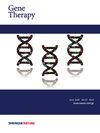揭示性别偏见:女性对AAV的先前存在和中和滴度较高,及其对基因治疗的影响。
IF 4.5
3区 医学
Q1 BIOCHEMISTRY & MOLECULAR BIOLOGY
引用次数: 0
摘要
用AAV载体进行基因治疗是治疗许多遗传疾病的一种很有前途的方法,但往往受到预先存在的抗体的阻碍,这些抗体可以中和载体。鉴于女性可能表现出比男性更强的免疫反应,本研究假设女性可能具有更高的预先存在的抗AAV抗体滴度。分析了来自美国两个队列的血清样本的抗体滴度、抗体亚型和对AAV1、AAV2、AAV5、AAV8和AAV9血清型的转导抑制活性。我们发现,在血清阳性样本中,女性对AAV9和其他血清型的抗体水平和中和活性较高。免疫球蛋白亚类分析显示,IgG1在两性中均占优势,但女性的IgA水平较高,而男性的IgG2水平较高。我们通过刺激男性和女性人pbmc进一步评估了这种对AAV的差异免疫反应的细胞水平。我们观察到雌性pbmc中细胞因子和趋化因子的剂量依赖性增加,这表明存在不同的炎症反应。总之,我们的研究结果表明,女性免疫反应的增强可能导致AAV载体的中和和更快的清除,这可能会影响基因治疗的效果。本文章由计算机程序翻译,如有差异,请以英文原文为准。

Unveiling the sex bias: higher preexisting and neutralizing titers against AAV in females and implications for gene therapy
Gene therapy with AAV vectors is a promising approach for treating numerous genetic disorders but is often hindered by preexisting antibodies that neutralize the vectors. Given that females may exhibit stronger immune responses than males, this study hypothesizes that females may have higher preexisting antibody titers against AAV. Serum samples from two U.S. cohorts were analyzed for antibody titers, antibody subtypes, and transduction inhibition activity against AAV serotypes AAV1, AAV2, AAV5, AAV8, and AAV9. We found that among seropositive samples, females had higher preexisting antibody levels and neutralizing activities against AAV9 and other serotypes. Immunoglobulin subclass analysis showed IgG1 dominance in both sexes, but females had higher IgA levels, whereas males had higher levels of IgG2. We further evaluated the cellular level of this differential immune response to AAV by stimulation of male and female human PBMCs. We observed dose-dependent increase in cytokines and chemokines in female PBMCs which suggests a differential inflammatory response. Altogether, our findings suggest that the enhanced immune response in females could lead to neutralization and faster clearance of AAV vectors with potential to impact the efficacy of gene therapy.
求助全文
通过发布文献求助,成功后即可免费获取论文全文。
去求助
来源期刊

Gene Therapy
医学-生化与分子生物学
CiteScore
9.70
自引率
2.00%
发文量
67
审稿时长
4-8 weeks
期刊介绍:
Gene Therapy covers both the research and clinical applications of novel therapeutic techniques based on a genetic component. Over the last few decades, significant advances in technologies ranging from identifying novel genetic targets that cause disease through to clinical studies, which show therapeutic benefit, have elevated this multidisciplinary field to the forefront of modern medicine.
 求助内容:
求助内容: 应助结果提醒方式:
应助结果提醒方式:


